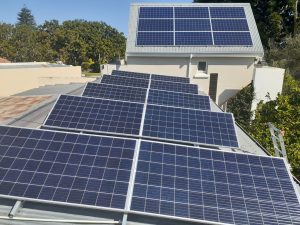Solar electricity is electricity that is created by converting the energy in sunlight to electrical energy. There are a few ways of doing this, but the most common method uses photovoltaic (PV) panels.
In this guide we will give a very brief overview of:
- Standard solar electricity equipment
- Installation types that can be implemented
There is a huge amount of in-depth information on solar power all over the web – this guide is intended to give a very high level overview of the solutions currently available.
Standard Equipment
In general, solar power systems can be grid-tie, off-grid or a hybrid thereof. We will cover each instance a little later. A typical solar system will consist of all or some of the following, depending on use case:
- Solar panels
- Charge Controller or regulator
- Solar inverter
- Batteries
- Various connectors, cables and accessories
Photovoltaic (PV) Panels
PV panels consist of a number of silicon photovoltaic cells in the form of two separate wafers, one charged negatively and one charged positvely. When exposed to the suns rays the wafers exchange electrons and these electrons are intercepted to form a DC current when connected to a circuit. The number and size of panels used will depend on your clients requirement.

Panel Cabling
The current leaving the panel (typically via a junction box on the back of the panel) is DC and therefore the cabling used to channel this current is critcal. If it‘s too thin, too much of the current will convert to heat causing poor efficiencies and perhaps even burning the cable. Too thick and you are introducing unnecessary cost to the system and your quote may not be competitive. A cable size calculator is included in our spec system and the size will be dependent on the cable run length, current through the cable and voltage of your system.

Charge Controllers
Charge controllers or regulators are only used in systems where batteries form part of the solution. The charge controller regulates the amount of current flowing into the batteries and prevent the batteries from being over charged.A regulator can also allow you to connect the panels direclty to the electrical load, bypassing the batteries where appropriate.
Solar Inverters
As you will know, an inverter converts DC current to AC current and adjusts the voltage to a domestically usable level (220-240V in many countries).A good quality inverter is absolutely critical to the success of any solar installation. In most applications the inverter will need to produce a pure sine wave output as opposed to a modified sine wave output which is often produced by cheaper inverters. Modified sine wave outputs are no good for any equipment with any sort of inductive load (motor) and should generally be avoided.It is also important that the inverter be able to handle the maximum current that your system can produce and to also safely shut things down should the load current be exceeded.
SMA 5KVA Inverter
Batteries
Often, there is no requirement to use the power generated by the system at that exact moment and that power then needs to be stored in batteries so that it can be used when required, typically during periods when the system is unable to function (night-time!)The correct battery to use in a solar power system is a DEEP CYCLE battery. A Deep Cycle battery is designed to be discharged to a much lower level than a regular battery (say a car battery) and can be discharged and re-charged many more time before it fails. Another difference is that while a car battery is designed to deliver short bursts of very high current, a Deep Cycle battery will generally deliver a lower but more continous draw, much more suitable for on-going applicati
Services
We design, supply and install solar photovoltaic solutions for residential and commercial customers. We work directly with the customer or through builders and electricians to ensure the right solution at the right price.
Products
Since every Watt of power generated via the sun comes with a price tag, solar electricity is not an area where sub-standard equipment can be utilised. We use only industry-leading panels, controllers, batteries and inverters to ensure that every possible Watt of power is extracted from your system.
Areas Of Operation
We currently operate in and around Cape Town, Johannesburg and Port Elizabeth.
Services
We design, supply and install solar photovoltaic solutions for residential and commercial customers. We work directly with the customer or through builders and electricians to ensure the right solution at the right price.
Products
Since every Watt of power generated via the sun comes with a price tag, solar electricity is not an area where sub-standard equipment can be utilised. We use only industry-leading panels, controllers, batteries and inverters to ensure that every possible Watt of power is extracted from your system.
Areas Of Operation
We currently operate in and around Cape Town, Johannesburg and Port Elizabeth.
